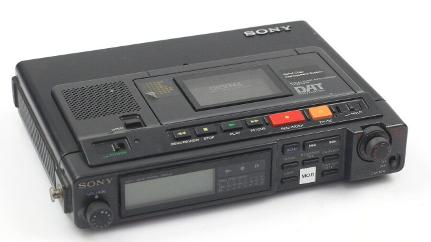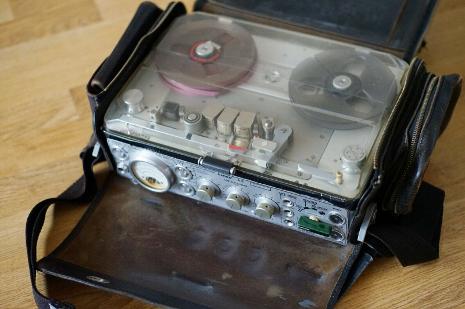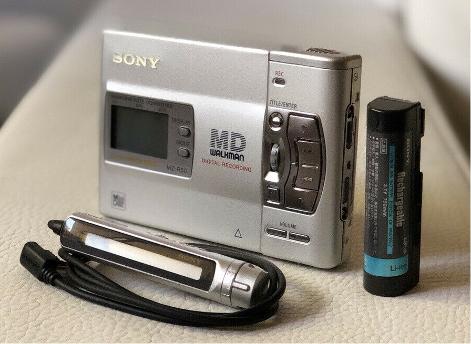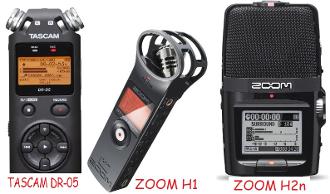CAMERA BLIMPS
The term Camera Blimp refers to a sound deadening cover that is placed on the camera, thereby reducing the noise emitted when it is running. Traditionally blimps are available almost exclusively for 16mm and 35mm film cameras. Due to the variety of Super8 camera designs and shapes, very few companies offer blimps for Super8 cameras. Homemade designs vary according to requirements, from a simple blanket to purpose built covers to suit most environments. An example of such a design is on the following web page..
RECORDING SOUND?
There are a number of audio recording options, both analogue and digital. Depending on the budget and method, recording audio can be accomplished by either using professional recorders such as DAT or Zoom recorders, or consumer digital recorders widely available. Amateur methods can be as cheap as using a laptop with recording software connected to a microphone. Professional devices are reliable, sturdy, high quality, and quick to setup. Consumer devices are cheaper, and quality may depend on how well they are made. Amateur devices may require effort to get working reliably, take time to setup, and audio quality may be reduced unless the setup is exact. The following are general examples of available devices:
MICROPHONES
Microphones are a touch more complex in variety, but can be simplified if you know how you want to record sound and with what quality. Considering that Super8 cameras are noisy, try to avoid omni-directional microphones . These will pick up every sound, especially a Super8 camera. Try to use cardioid or super cardioid microphones. Cardioid are common ‘singing’ mics, they pick up mostly what is directly in front of them. Super cardioid (shotgun) mics are very directional, in some ways ideal for Super8, but one has to be careful not to aim away from the person speaking and pick up sound bouncing off the wall behind them. Cardioid microphones are a good compromise, cheap to purchase, second hand between $90 to $150. Super cardioid are expensive, yet very effective.
Also be aware of the differences between dynamic and condenser microphones. Dynamic are more expensive and require no power source from the recording device, a simple plug and listen mike. Condenser mikes are cheaper, and often do not need external power, yet high-end condenser mikes may require "phantom power" to pick up sound. These mikes may require a microphone pre-amp. Mains powered pre-amp's are cheap new, yet portable ones are quite expensive. A recent device that supplies pre-amp power to microphones is Cloudlifter. A very effective way of turning a Shure SM58 into the perfect portable audio recorder.
SOUND AND SUPER8 CAMERAS
Many Super8 camera's are able to use sound striped Super8 film. Once processed this film can then be played on a sound projector. Unfortunately this type of film has not been manufactured since the early 1990's. There are stocks still available, and some in good usable condition if they have been kept frozen. Camera's designed to use sound film can also use silent film, and usually run quieter than non-sound recording Super8 cameras. Recording audio with a Super8 cameras will require the camera to be quietened, for instance with a blimp.
SOUND AND 16mm CAMERAS
16mm cameras come in four major flavours: professional, high-end consumer, B roll/MOS, and spring-wound. Professional 16mm cameras, if serviced, can run silently. These cameras are the best, but are expensive. High-end consumer 16mm cameras, if serviced, can run quietly, however, more effort will be needed to use with audio recorders. B roll/MOS 16mm cameras are designed for use without audio, and therefore are quite noisy. Although spring-wound 16mm cameras were mostly designed for use without audio, many, when serviced, can run quietly and with some ingenuity a filmmaker can easily record sound with a spring-wound camera. To find out which cameras are best for your needs, research what they were originally intended for. This will be the best way to judge which camera fits your needs.

D.A.T RECORDERS
Digital Audio Tape recorders were, at the time of development, considered the natural progression from professional reel to reel and high-end cassette analogue recording to advanced digital recording. At the time, hard drives were comparatively fragile, expensive, and cumbersome for portable recording. The DAT was marketed as the best of both worlds. Reliable, light, portable, and quality tape meant durable recordings. DAT recorders and tape are still available and can be purchased for under $350. For more information try: HERE

REEL-TO-REEL RECORDERS
Reel to reel recorders were for a long time the best device available for professional audio recording. Considering there are many adapters available to convert analogue to digital, and therefore enable computer editing of the audio, quality reel to reel recorders are still sought after and frequently used by filmmakers. Many audiophiles consider audio recorded onto tape to be of a better quality over digital as there is no compression of analogue audio. There are many types of digital compression codecs used by various recording device manufacturers. Choosing a digital device will often mean choosing one type of audio codec. Reel to reel recorders and tape are still available and can be purchased for under $1350. The brand Nagra is considered the best made. For more information on reel to reel, try: HERE

MINI DISK RECORDERS
Instead of purchasing professional and high-end recorders, which can cost up to $1500 second-hand, there is the commonly available Minidisc. These are essentially pocket sized portable ‘walkmans’ that use Minidiscs to play music and record sound digitally. All one has to do is connect a microphone via a commonly available adapter, connect headphones to listen to quality, adjust recording level, and record. Minidisc players/recorders are widely available in Australia, either in second hand shops or ebay. The minidisc media, or disks, are affordable and available via online auction sites. You can purchase a Minidisc player/recorder for between $40 to $170 online. MiniDiscs are no longer available new. This is not to say they are unreliable or poor quality, just that Mp3 players have dominated the market. For years MiniDisc's where the choice of musicians recording either live gigs or at home, proving they are rugged and reliable. For more information on Minidiscs, try: HERE and for solutions on using them with modern computers, try HERE

DIGITAL RECORDERS
Digital recorders are the current standard. Although being small, high quality, easy to adjust, load the audio onto computers, and widely available, they can be quite expensive, depending on which model is bought. Digital recorders come in a variety of types to cover ever recording need. Attaching microphones can be very easy, as well as a large range of accessories. A good place to start researching is HERE.
LAPTOP COMPUTERS
The Laptop computer, or any portable computer, tablet, or even smart phone, with capable software can be capable of recording digital sound. The internet offers many recording programs for free download, as well as countless "Apps". Although the portable computer can be very handy recording sound, they are still comparatively expensive and cumbersome compared to a MiniDisc or digital recorder. Simply purchase an old laptop, one that has a sound card that is capable of recording at least 16bit digital sound. This information can be found under specifications, buy a new battery and viola! You have a portable digital recorder.
DISCLAIMER:
This is a Copyright Disclaimer under section 107 of the Copyright Act of 1976, allowance is made for “fair use” for purposes such as criticism, comment, news reporting, teaching, scholarship, education and research. Fair use is a use permitted by copyright statute that might otherwise be infringing. Fair Use permits limited use of copyrighted material without having to first acquire permission from the copyright holder. Fair use is one of the limitations to copyright intended to balance the interests of copyright holders with the public interest in the wider distribution and use of creative works by allowing as a defence to copyright infringement claims certain limited uses that might otherwise be considered infringement. The creator of this website declares that information and photographs copied from other websites and placed here is solely for the purpose of education and research. The creator of this website does not earn money from information published here. The creator of this website always references, where possible, the original creator of work that is published here. If any person wants to dispute this, and/or believes the creator of this website has infringed on a person's copyrighted creative material, please email me at mishkin.film@gmail.com This email address is checked frequently.